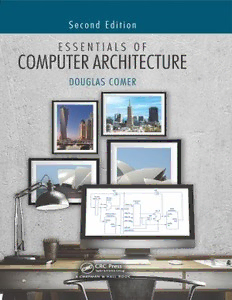Table Of ContentE S S E N T I A L S O F
COMPUTER ARCHITECTURE
Second Edition
E S S E N T I A L S O F
COMPUTER ARCHITECTURE
S e c o n d E d i t i o n
DOUGLAS COMER
SPARC is a registered trademark of SPARC International, Inc. in the United States and other countries.
ARM is a registered trademark of ARM Limited in the United States and other countries.
MIPS is a registered trademark of MIPS Technologies, Inc. in the United States and other countries.
Itanium and Xeon are trademarks of, and Intel and Pentium are registered trademarks of Intel Corporation.
All other trademarks referred to herein are the property of their respective owners.
CRC Press
Taylor & Francis Group
6000 Broken Sound Parkway NW, Suite 300
Boca Raton, FL 33487-2742
© 2017 by Taylor & Francis Group, LLC
CRC Press is an imprint of Taylor & Francis Group, an Informa business
No claim to original U.S. Government works
Printed on acid-free paper
Version Date: 20161102
International Standard Book Number-13: 978-1-138-62659-1 (Hardback)
This book contains information obtained from authentic and highly regarded sources. Reasonable efforts have been
made to publish reliable data and information, but the author and publisher cannot assume responsibility for the valid-
ity of all materials or the consequences of their use. The authors and publishers have attempted to trace the copyright
holders of all material reproduced in this publication and apologize to copyright holders if permission to publish in this
form has not been obtained. If any copyright material has not been acknowledged please write and let us know so we may
rectify in any future reprint.
Except as permitted under U.S. Copyright Law, no part of this book may be reprinted, reproduced, transmitted, or uti-
lized in any form by any electronic, mechanical, or other means, now known or hereafter invented, including photocopy-
ing, microfilming, and recording, or in any information storage or retrieval system, without written permission from the
publishers.
For permission to photocopy or use material electronically from this work, please access www.copyright.com (http://
www.copyright.com/) or contact the Copyright Clearance Center, Inc. (CCC), 222 Rosewood Drive, Danvers, MA 01923,
978-750-8400. CCC is a not-for-profit organization that provides licenses and registration for a variety of users. For
organizations that have been granted a photocopy license by the CCC, a separate system of payment has been arranged.
Trademark Notice: Product or corporate names may be trademarks or registered trademarks, and are used only for
identification and explanation without intent to infringe.
Library of Congress Cataloging‑in‑Publication Data
Names: Comer, Douglas, author.
Title: Essentials of computer architecture / Douglas Comer.
Description: Second edition. | Boca Raton : Taylor & Francis, a CRC title,
part of the Taylor & Francis imprint, a member of the Taylor & Francis
Group, the academic division of T&F Informa, plc, [2017] | Includes index.
Identifiers: LCCN 2016041657 | ISBN 9781138626591 (hardback : alk. paper)
Subjects: LCSH: Computer architecture.
Classification: LCC QA76.9.A73 C625 2017 | DDC 004.2/2--dc23
LC record available at https://lccn.loc.gov/2016041657
Visit the Taylor & Francis Web site at
http://www.taylorandfrancis.com
and the CRC Press Web site at
http://www.crcpress.com
To Chris, who makesall the
bits of life meaningful
Contents
Preface xxi
Chapter1 IntroductionAndOverview 3
1.1 TheImportanceOf Architecture 3
1.2 Learning The Essentials 3
1.3 Organization Of TheText 4
1.4 WhatWeWill Omit 4
1.5 Terminology:ArchitectureAndDesign 5
1.6 Summary 5
PART I Basics 7
Chapter2 FundamentalsOfDigitalLogic 11
2.1 Introduction 11
2.2 Digital Computing Mechanisms 11
2.3 ElectricalTerminology:VoltageAndCurrent 12
2.4 TheTransistor 13
2.5 Logic Gates 14
2.6 ImplementationOfANand Logic GateUsing Transistors 16
2.7 SymbolsUsedForLogic Gates 17
2.8 ExampleInterconnectionOf Gates 17
2.9 ADigital Circuit For BinaryAddition 20
2.10 Multiple GatesPerIntegratedCircuit 22
2.11 TheNeedForMoreThan Combinatorial Circuits 22
2.12 Circuits That Maintain State 23
2.13 Propagation Delay 24
2.14 Using LatchesTo CreateAMemory 24
2.15 Flip-Flops AndTransition Diagrams 25
2.16 BinaryCounters 27
2.17 ClocksAndSequences 28
2.18 TheImportant ConceptOfFeedback 31
2.19 Starting ASequence 32
viii Contents
2.20 IterationInSoftware Vs.ReplicationInHardware 33
2.21 GateAndChip Minimization 34
2.22 Using SpareGates 34
2.23 PowerDistribution AndHeatDissipation 35
2.24 Timing AndClockZones 35
2.25 ClocklessLogic 37
2.26 Circuit SizeAndMoore’sLaw 38
2.27 Circuit Boards AndLayers 39
2.28 LevelsOf Abstraction 39
2.29 Summary 40
Chapter3 DataAndProgramRepresentation 45
3.1 Introduction 45
3.2 Digital Logic AndTheImportanceOf Abstraction 45
3.3 Definitions Of Bit AndByte 46
3.4 ByteSizeAndPossible Values 46
3.5 BinaryWeightedPositional Representation 47
3.6 Bit Ordering 48
3.7 HexadecimalNotation 49
3.8 Notation ForHexadecimalAndBinaryConstants 51
3.9 CharacterSets 51
3.10 Unicode 52
3.11 UnsignedIntegers,Overflow,AndUnderflow 53
3.12 NumberingBits AndBytes 53
3.13 SignedBinaryIntegers 55
3.14 AnExampleOfTwo’s ComplementNumbers 56
3.15 Sign Extension 57
3.16 Floating Point 58
3.17 RangeOf IEEEFloating Point Values 59
3.18 SpecialValues 60
3.19 BinaryCodedDecimalRepresentation 61
3.20 Signed,Fractional, AndPackedBCDRepresentations 62
3.21 DataAggregates 62
3.22 ProgramRepresentation 63
3.23 Summary 63
Contents ix
PART II Processors 65
Chapter4 TheVarietyOfProcessors AndComputationalEngines 69
4.1 Introduction 69
4.2 TheTwo BasicArchitecturalApproaches 69
4.3 TheHarvardAndVonNeumannArchitectures 70
4.4 Definition Of AProcessor 71
4.5 TheRangeOf Processors 72
4.6 HierarchicalStructureAndComputational Engines 73
4.7 StructureOfAConventional Processor 74
4.8 ProcessorCategories AndRoles 75
4.9 ProcessorTechnologies 77
4.10 StoredPrograms 77
4.11 TheFetch-ExecuteCycle 78
4.12 ProgramTranslation 79
4.13 ClockRateAndInstruction Rate 79
4.14 Control: Getting Started AndStopping 80
4.15 Starting The Fetch-ExecuteCycle 81
4.16 Summary 82
Chapter5 ProcessorTypesAndInstructionSets 85
5.1 Introduction 85
5.2 MathematicalPower,Convenience,AndCost 85
5.3 Instruction SetArchitecture 86
5.4 Opcodes,Operands,AndResults 87
5.5 TypicalInstruction Format 87
5.6 Variable-LengthVs.Fixed-LengthInstructions 87
5.7 General-PurposeRegisters 88
5.8 Floating Point RegistersAndRegisterIdentification 89
5.9 ProgrammingWith Registers 89
5.10 RegisterBanks 90
5.11 ComplexAndReducedInstruction Sets 91
5.12 RISCDesignAndTheExecutionPipeline 92
5.13 PipelinesAndInstruction Stalls 93
5.14 OtherCauses Of PipelineStalls 95
5.15 ConsequencesFor Programmers 95
5.16 Programming,Stalls, AndNo-OpInstructions 96
5.17 Forwarding 97
5.18 TypesOfOperations 97
5.19 ProgramCounter, Fetch-Execute,AndBranching 98
5.20 Subroutine Calls, Arguments,AndRegisterWindows 99

